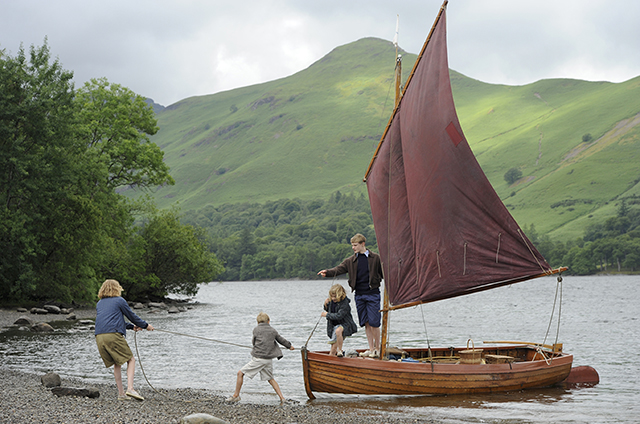A new documentary film detailing the incredible voyage of Robert Manry, who set the record in 1965 for the smallest boat to ever cross the Atlantic non-stop, has been released.
When Robert Manry landed at Falmouth, Cornwall, 78 days after seeing out from Falmouth, Massachusetts, he became an inspiration to generations of small boat sailers.
Now, a new documentary, Manry at Sea, has been released with original footage shot by the American sailor during his crossing in the 13.5ft Tinkerbelle, along with archive news footage of his arrival in Falmouth (thousands of people turned out to welcome him) and interviews by the film’s producer and director Steve Wystrach.
‘He was really a DIY boater. I am not much of one myself but he inspired me – his love of sailing, his tenacity and careful planning. He is a very inspiring character,’ Wystrach told PBO.
‘He set off to do something that I had dreamed of doing, mainly sailing out into the wild blue deep, crossing the winds and waves to some place far off beyond the horizon. Most importantly, his was a dream come true, and he made it come true by himself. Despite his social standing, that he was risking his children’s futures, what others might think, or whether he might not survive the voyage, he knew this was a self-defining need, something he had to do. He would not have been a complete Robert Manry if he had never set sail in Tinkerbelle,’ continued Wystrach.
‘Through perseverance, planning, determination, craftsmanship, patience, and economy, he pretty much did everything by himself. He looked at every potential problem head on, and found a solution. And because he died so early, I think his story is a potent reminder, and should be a good kick in the stern for everyone, sailors and landlubbers alike, that if you have a dream, you’d better get on with it, since time is always slipping away,’ he added.
The premise for the film came in the mid 1990s when Wystrach, himself a offshore long distance sailor, was re-reading his copy of Manry’s best selling book, Tinkerbelle, which charts the record breaking passage.
‘There is an extensive appendix including an equipment list, and I read that he took with him a 16mm movie camera and 52 magazines of film. A bell went off in my head – where was the film? This started a two year archival journey to track down it down,’ explained Wystrach.

Arriving in Falmouth. Credit: Getty Images/Bettmann
Eventually located at Manry’s brother’s house in Canada, the film included footage of some of the storms Manry had to endure.
‘I started interviewing people who were involved in the story and found all of the news footage shot at the time, and I saw that I had enough for an interesting film which was not only about Manry and his dream to cross the ocean but about how the news media picked up the story and took one man’s adventure and turned it into a media frenzy,’ stated Wystrach.
Continues below…
Watch: Trailer for the Donald Crowhurst film, The Mercy, is released
The preview of the new Donald Crowhurst biopic, The Mercy, is now out ahead of the film's release in February…
Swallows and Amazons film remake in cinemas
The remake of Swallows and Amazons, filmed on location in the Lake District, Yorkshire and Scotland, will be in cinemas…
Not only did Manry’s own employers, The Plain Dealer newspaper in Cleveland, Ohio, send his family, along with three of its staff to Falmouth to await Manry’s arrival, but other media outlets also got wind of the story and dispatched TV newsman Bill Jorgensen to be the first to interview Manry.
While the Plain Dealer persuaded the RAF to conduct practice search and rescue exercises to look out for him, the rival Scripps-Howard Station WEWS news station had contacts at Lloyds of London, according to Wystrach.

It is hoped the film will be shown in the UK
As soon as Tinkerbelle had been spotted by the tanker, Belgulf Glory and its position radioed to Lloyds, Bill Jorgnsen was tipped off.
‘He had already gone down to Penzance and hired the best fishing trawler captain and had paid him to stay in port with a full crew until they had Manry’s location,’ continued Wystrach.
‘When Jorgensen got word, they put to sea within an hour and took a day and a half to track him down. The TV reporter interviewed him and it was the scoop of the year in the US’.
Just hours after the interview, an RAF Shackelton bomber dropped two canisters close to Tinkerbelle’s position, containing fruit, newspapers and a notes from the Plain Dealer and from Manry’s wife, Virginia – this was the first time he knew that he wife would be waiting for him.
‘His voyage was the last hurrah of basic seamanship,’ said Wystrach, who added that nowadays big ships were unlikely to stop for other craft as ‘they are just programmed to do their course’.
Wystrach has applied to show the film at the Edinburgh International Film Festival in June 2018 and is still waiting to find out if he has been successful. He also has a wish to show it in Falmouth – ‘the natural place for it it be screened’.
A trailer for Manry at Sea can be viewed at robertmanryproject.com.
Manry at Sea will have its world premier at the Cleveland International Film Festival on 5 April.






